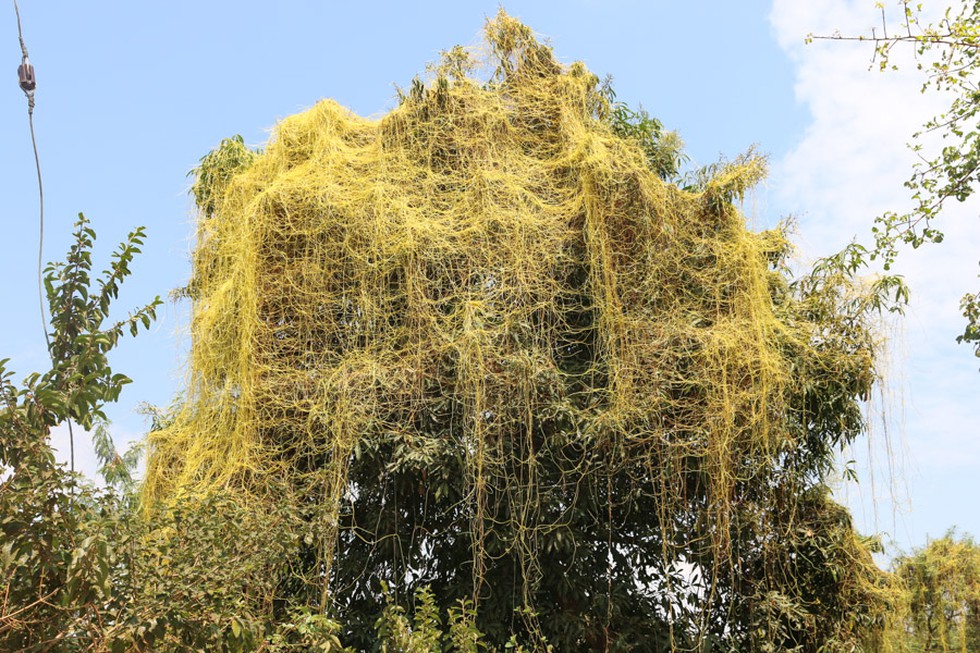An invasive species, Cuscuta dodder, native to North America, is threatening the Chengalpet forests and Vedanthangal Bird Sanctuary. This parasitic vine lacks roots and is causing significant harm to local vegetation, ecology, and the habitat of migratory birds.
Spread and Impact:
- Extent of Infestation: Cuscuta dodder has already infested vast areas of trees in the reserve forests and has begun spreading within India’s oldest bird sanctuary.
- Damage to Canopy: The plant covers the canopy of Barringtonia trees, which are favored by migratory water birds for nesting, posing a serious threat to their habitat.
- Modus Operandi: Cuscuta builds a dense canopy on the host plant and sends out tendrils that eventually strangle and kill the host.
Current Actions and Challenges:
- Manual Removal: Forest staff have been manually removing Cuscuta during the summer months when water levels in the lake recede and migratory birds leave. However, this is a temporary solution.
- Timing of Action: Due to regulations, action against Cuscuta can only be taken after the migratory bird season, delaying effective measures.
- Extent Beyond Sanctuary: Cuscuta spread is not confined to the sanctuary; it’s also infesting tens of acres in the reserve forests of Thiruporur, Chengalpet district, posing a broader ecological threat.
Expert Perspectives:
- Botanists’ Concern: Botanists emphasize the urgency of addressing the Cuscuta spread in Vedanthangal, highlighting the need for immediate action.
- Naturalist’s Observation: A biodiversity study conducted by a naturalist reveals extensive infestation in Thiruporur forest, urging the forest department to intervene.
- Taxonomist’s Input: A leading taxonomist underscores the importance of identifying Cuscuta species accurately for effective control measures.
Regional and International Context:
- National Impact: Cuscuta poses a significant problem in various Indian states, affecting crops like oilseeds, pulses, and fodder.
- Global Recognition: Internationally, Cuscuta is recognized as a ‘declared noxious weed’ in 25 countries, with strict regulations on seed and plant material movement.
Multiple Choice Questions (MCQs):
- Where is Cuscuta dodder native to?
- A) Europe
- B) South America
- C) North America
- D) Africa
- Answer: C) North America
- What method does Cuscuta dodder use to harm its host plants?
- A) Through direct consumption of nutrients from the soil
- B) By physically attacking the host with thorns
- C) By building a dense canopy and strangling the host
- D) By emitting toxins that harm the host plant
- Answer: C) By building a dense canopy and strangling the host
- What challenges do authorities face in addressing the Cuscuta infestation in Vedanthangal Bird Sanctuary?
- A) Lack of public awareness
- B) Strict regulations delaying action until after migratory bird season
- C) Limited manpower for manual removal
- D) Inadequate funding for eradication efforts
- Answer: B) Strict regulations delaying action until after migratory bird season
- In which Indian states is Cuscuta a significant problem according to the National Research Centre for Weed Science?
- A) Karnataka and Kerala
- B) Punjab and Haryana
- C) Andhra Pradesh, Chhattisgarh, Gujarat, Orissa, West Bengal, and parts of Madhya Pradesh
- D) Uttar Pradesh and Bihar
- Answer: C) Andhra Pradesh, Chhattisgarh, Gujarat, Orissa, West Bengal, and parts of Madhya Pradesh
- What distinguishes Cuscuta seeds from those of root parasites?
- A) They require a specific stimulant for germination
- B) They have a hard coat and can survive for several years without germinating
- C) They are larger in size compared to root parasite seeds
- D) They can only germinate in specific soil conditions
- Answer: B) They have a hard coat and can survive for several years without germinating
